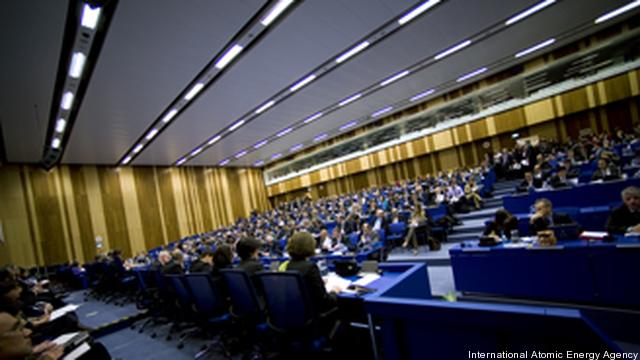Iran’s Parchin Test Site: What UN Nuke Inspectors Think They’ll Find
Posted on
 The IAEA Board of Governors at its deliberations on Iran earlier this month.
The IAEA Board of Governors at its deliberations on Iran earlier this month.
UN nuclear inspectors have honed in on Parchin, a military testing ground 30 kilometers southeast of Tehran, in their inquest into whether Iran is secretly developing nuclear weapons. Iran is dragging its feet on access to this site, but the UN watchdog International Atomic Energy Agency has drawn a line in the sand. It says that visiting Parchin must be the next step in an investigation that began in 2003 and has been stalled for the past four years over questions about the possible military dimensions of Iran’s nuclear work.
The IAEA thinks there may have been tests at Parchin on the trigger for an atomic bomb, possibly involving natural uranium, in what would have been a dry test rather than a chain reaction. Proof that Iran used uranium in military research would destroy Iran’s central claim that its program has made only peaceful use of nuclear material. Iran says it seeks to use atomic power for energy and other civilian ends but the United States fears the Islamic Republic is hiding a drive to build, or to be able to build, the bomb.
This article presents key facts about Parchin and the IAEA investigation, gleaned from IAEA documents as well as reliable sources.
The Parchin testing grounds cover 42 square kilometers, but the area the IAEA wants to visit is in a sector isolated from the military activities at the site. There is at least one access road to this area which does not go through active military sites, and the IAEA argues that this would make it relatively easy for Iran to allow a visit. IAEA inspectors had visited Parchin twice in 2005 but at spots more central to the military area, and they found nothing suspicious. They clearly feel they have better information this time.
Specifically, the IAEA is now focusing on a massive cylinder some 19 meters (288 feet) long, which was installed in the year 2000 and which may have housed explosion tests sometime before 2003. The metal cylinder is 4.6 meters in diameter but is reinforced in the middle with concrete, almost doubling the diameter to 7.6 meters. This apparatus is inside a building, blocking direct observation from satellites. It is possible the cylinder is no longer there – but analysts said it would not look good for Iran to have dismantled the apparatus just when the IAEA is seeking to inspect it.
Satellites are detecting more activity at this site than in the last 7 or 8 years, Yet orbital imagery has its limits. The pictures reportedly show the presence of trucks but not actual work taking place, and the resolution is only about 50 centimeters, which limits the ability to see individual people moving around. Also work at night could be invisible to the satellites.
Iran has rejected charges that what the satellites are showing is an effort to clean up the Parchin site. Foreign Ministry spokesman Ramin Mehmanparast told reporters in Tehran on Tuesday that uranium traces cannot be cleaned up, as tiny particles would remain after any effort to sanitize an area. He insisted that only “conventional military” activities are carried out at Parchin.
The UN watchdog is skeptical. An IAEA report in November spoke of two types of experiments which Iran may have carried out. The first is hydrodynamic tests, which are simultaneous explosions to compact a spherical nuclear core. The core for such tests would not be enriched uranium, since this could set off an actual atomic explosion. But surrogates such as tungsten or natural uranium, not enriched to the level needed for a chain reaction, can be used, and traces of these can theoretically be found even years later. The IAEA is focusing on this hydrodynamic testing, so-called because the core becomes fluid as it is compacted. But there is also the possibility that the explosions would have been to test a neutron initiator, a tiny capsule in the center of the bomb core which bathes the nuclear material with neutrons, thus accelerating a chain reaction. This procedure could involve uranium deuteride, a surrogate for enriched uranium and which might leave tell-tale traces.
In possible connection with these suspected tests, the IAEA is investigating whether Iran diverted some 20 kilograms of natural uranium “in the form of natural uranium metal and process waste” from the Jabr Ibn Hayan Multipurpose Research Laboratory, according to the November IAEA report. The IAEA is moving cautiously on this charge, however, as the evidence relies on potentially unreliable weighing of nuclear material. But proof of such a diversion from civilian research to a military program, especially to Parchin, would be close to a “smoking gun” that would discredit Iran’s claim to have a strictly peaceful program.
The IAEA has also quizzed a Ukrainian scientist, Vyacheslav Danilenko, about Parchin. It said in its November report that it had “strong indications” a “foreign expert” had assisted Iran in working on developing a “high explosives” trigger for a bomb. The IAEA said the expert was in Iran “from about 1996 to about 2002” to help develop “a facility and techniques for making ultra-dispersed diamonds (‘UDDs’ or ‘nanodiamonds’).” The sort of cylinder which is at Parchin can be used for nanodiamonds. The unnamed expert has been identified as Danilenko, who had another expertise. He had worked for the Soviet Union on designing nuclear weapons small enough to fit in a missile, bomb or artillery shell.
In any case, the IAEA wonders why the Iranians are denying the agency access to a site where civilian diamonds research, rather than military testing, allegedly took place.
Subscribe to our newsletter
Promotions, new products and sales. Directly to your inbox.
